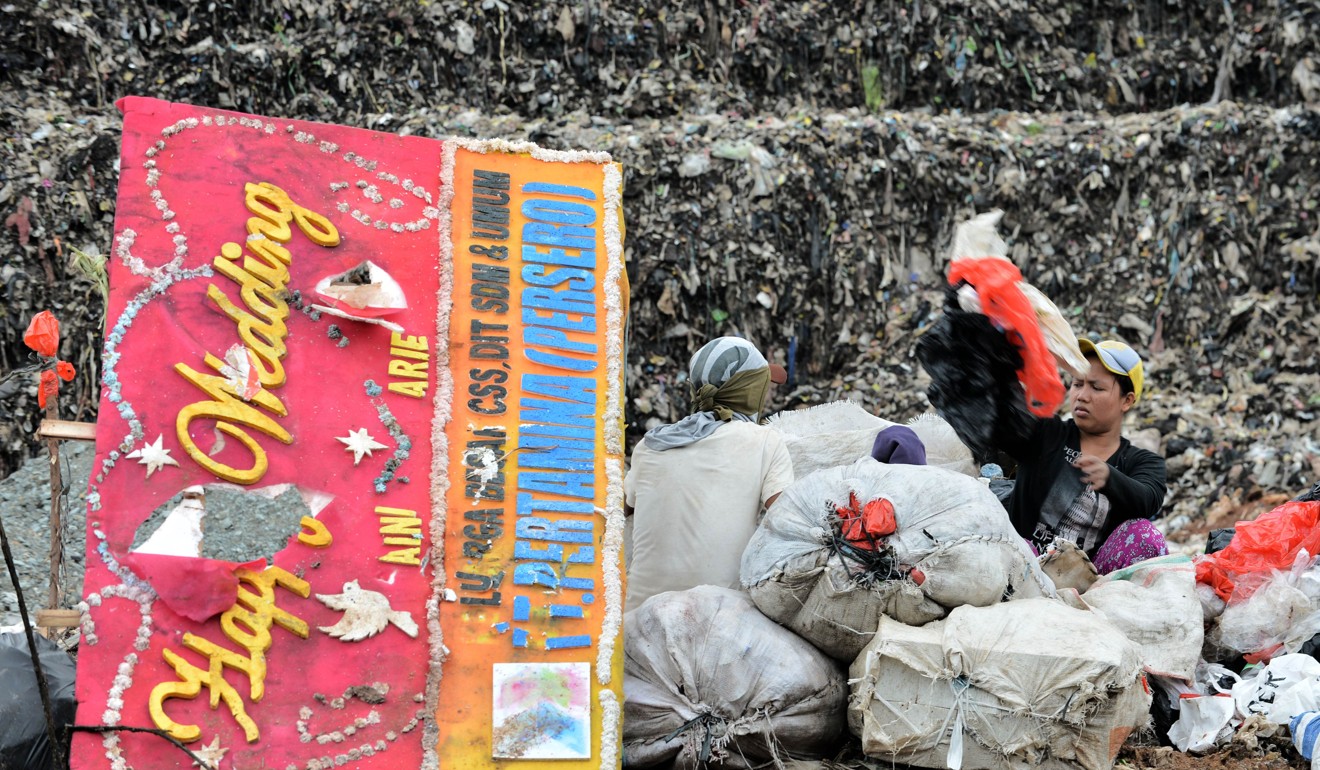West lies, locals say as waste piles higher in Jakarta’s vast landfill

- At the end of 2017, China banned the import of waste materials and an entire ‘do-gooder’ ecosystem collapsed as a result
- Now the landfills of Southeast Asia are overflowing and the West has no credible solution to a problem of its own making
Bantar Gebang is the largest uncovered landfill in Southeast Asia – a vast, 120-hectare moonscape of toxic, foul-smelling waste serving the greater Jakarta region, which is home to 32 million people. The landfill holds an estimated 39 million tonnes of garbage, with 7000 tonnes added daily. It should reach its capacity of 49 million tonnes by 2021, if not before.
Ibu Suki Sri, 52, started scavenging at the facility when it first opened 30 years ago. Back then the rubbish was deposited in a series of craters left behind by quarrying activity. Now, Bantar Gebang from a distance resembles 10 small hills.
Ibu Sri no longer combs through the trash herself. She has become a collector, managing a team of scavengers who in turn hunt for plastic bottles, straws, medical plastic containers (low density polythene/HDPE plastic), shoes, aluminium, metal and tin. Once sorted, graded and cleaned, the trash has some economic value: a sack of plastic bottles can be sold for 5,000 rupiah/kg (US 35 cents). HDPEs fetch 7,000 rupiah/kg.
Ibu Sri is unconcerned by the prospect of Bantar Gebang closing.
“I don’t think Bantar Gebang will be closed any time soon,” she says. “But if it does, I’ll just move to another dumpsite. Wherever the trash goes, I’ll follow.”
There are Bantar Gebangs all over Southeast Asia: Tondo in Metro Manila, Da Phuoc in Ho Chi Minh City. They are testament to a fundamental flaw of the economic growth and prosperity narrative widely accepted as the gospel truth. The unfettered consumerism and consumption that underpins our lives is unsustainable.

Every toothpaste tube, shampoo bottle, yogurt carton, confectionery wrapper and flimsy pink plastic shopping bag ends up somewhere like Bantar Gebang, Tondo or worse, floating somewhere on the open seas.
. The “National Sword” policy dealt a nearly fatal blow to the US$200 billion global recycling industry and the consequences are still rippling across Southeast Asia, Europe and North America.
An entire “do-gooder” ecosystem of recycling bins, depots and incinerators has evolved to allow Western consumers to think they can continue their profligate ways without harming the environment. This is nonsense. In fact, it is rubbish. The ecosystem was only workable as long as the Chinese were willing to import the detritus of Western consumerism: from hazardous waste to plastics and e-waste.
When the Chinese realised the impact of millions of tonnes of waste on their own environment, they changed their minds and the entire edifice collapsed. The Western idea that recycling this waste is possible has been revealed as fraudulent. We now know recycling isn’t free. Nor is it an environmental positive.
As Southeast Asia drowns in thousands of tonnes of hazardous waste, the recriminations on both sides have been bitter.
of plastic to 14 countries and the Philippines returned 69 containers to Canada, accompanied by the usual bluster of President Rodrigo Duterte.

In reality, Southeast Asian countries can barely manage their own rubbish, let alone the West’s.
In Jakarta, there are plans to create a US$250 million intermediate treatment facility zone by 2022 that could store 2,200 tonnes of waste to replace Bantar Gerbang. That will probably not be enough, though, given the city produces 7,000 tonnes of waste per day.
Even if more landfills could be created, the fundamental problem would remain: ultimately, what will the people of Jakarta, Southeast Asia and the world do with all the waste produced by 21st-century lifestyles and expanding consumerism?
Technology and global integration have failed us on these counts. Exporting trash as the Europeans and Americans have been doing is hypocritical and self-defeating.
Calls for both manufacturers and individuals to change their practices or habits only go so far. Instead, the solution requires a total overhaul of the sale and distribution practices in “fast-moving consumer industries”. Waste management will be temporary if we do not re-educate consumers, producers and retailers. Anything in between will fail, sweeping the rubbish under the carpet – or in Bantar Gerbang, piling it ever higher.
South China Morning Post
- Previous Lira drops after Ankara takes delivery of Russian missile system
- Next Central Asia-China pipeline: 270bn cubic meters of gas transported













